人教版初一上册英语1
人教版初一英语七年级上册Unit 1知识点

人教版初一英语七年级上册Unit 1知识点Unit 1 My name's Gina.【重点单词】name /neim/ n. 名字;名称nice /nais/ adj. 令人愉快的;宜人的to /tu:/ 常用于原形动词之前,该动词为不定式meet /mi:t/ v. 遇见;相逢too /tu:/ adv. 也;又;太your /jɔ:/ pron. 你的;你们的Ms. /miz/ (于女子的姓名前,不指明婚否)女士his /hiz/ pron. 他的and /ænd/ conj. 和;又;而her /hə:/ pron, 她的yes /jes/ interj. 是的;可以she /ʃi:/ pron. 她he /hi:/ pron. 他no /nəu/ interj. 不;没有;不是not /nɔt/ adv. 不;没有zero /'ziərəu/ num. 零one /wʌn/ num. 一two /tu:/ num. 二three /θri:/ num. 三four /fɔ:/ num. 四five /faiv/ num. 五six /siks/ num. 六seven /'sevn/ num. 七eight /eit/ num. 八nine /nain/ num. 九telephone /'telifəun/ n. 电话;电话机number /'nʌmbə/ n. 号码;数字phone /fəun/ n. 电话;电话机telephone/phone number 电话号码first /fə:st/ adj. 第一first name 名字last /la:st/ adj. 最后的;末尾的last name 姓friend /frend/ n. 朋友China /'tʃainə/ 中国middle /'midl/ adj. 中间的;中间school /sku:l/ n. 学校middle school 中学;初中知识点:1.短语归纳:Your name 你的名字first name 名字last name 姓氏her name 她的名字telephone /phone number 电话号码in China 在中国2.必背典句:1.—nice to meet you! 见到你很高兴!—Nice to meet you,too. 见到你我也很高兴。
人教版七年级英语上册Unit1【重点短语+词法语法句法精讲】
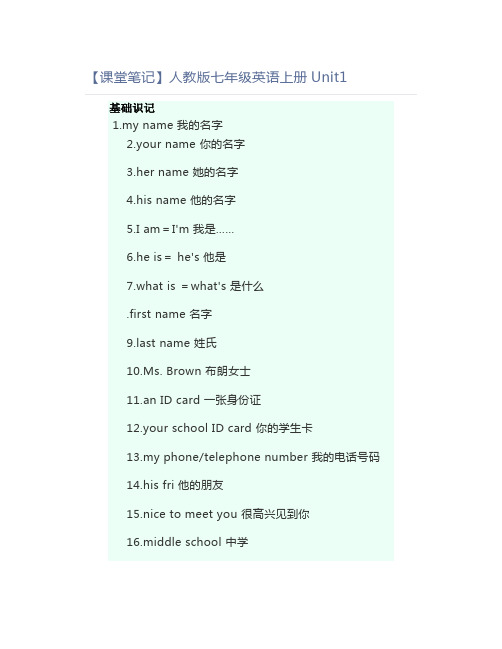
【课堂笔记】人教版七年级英语上册Unit1基础识记1.my name 我的名字2.your name 你的名字3.her name 她的名字4.his name 他的名字5.I am=I'm 我是……6.he is= he's 他是7.what is =what's 是什么.first name 名字st name 姓氏10.Ms. Brown 布朗女士11.an ID card 一张身份证12.your school ID card 你的学生卡13.my phone/telephone number 我的电话号码14.his fri 他的朋友15.nice to meet you 很高兴见到你16.middle school 中学17.eight seven eight nine double three two five 79-33251.in China 在中国重点句型1.—What's your name? 你叫什么名字?—Alan./I'm Alan./Myname's Alan.我叫艾伦。
2.—What's his/her name? 他/她叫什么名字?—He's Eric./His name'sEric./She's Mary./Her name's Mary.他叫埃里克。
/她叫玛丽。
3.—What's your first name? 你的名字是什么?—My first name is Gina. 我的名字是吉娜。
4.—What's your last name? 你姓什么?—My last name is Green. 我姓格林。
5.—My name's Jenny Green.我的全名是珍妮·格林。
—I'm Gina. Nice to meetyou!我是吉娜。
人教版七年级英语上册 unit 1 句式讲解及知识点梳理

人教版七年级英语上册unit 1 句式讲解及知识点梳理01Unit1 单词name ['neim] n.名字;名称nice ['nais] adj.令人愉快的;宜人的to [tu:, tu, tə] 常用于原形动词之前,表示该动词为不定式meet [mi:t] v.遇见;相逢too[tu:] adv.也;又;太your [jɔ:]pron.你的;你们的Ms. n.(不指名婚否)女士his [his] pron.他的and [ænd, ənd] conj.和;又;而her [hə:, hə] pron.她的yes [jes] interj.是的;可以she [ʃi:, ʃi] pron. 她he [hi:] pron.他no [nəu] interj.不;没有;不是not [nɔt] adv.不;没有zero ['ziərəu] num.零one [wʌn] num. 一two[tu:] num. 二three[θri:] num.三four [fɔ:]num. 四five [faiv]num. 五six [siks] num.六seven ['seven] num.七eight [eit] num. 八nine [nain] num.九telephone ['telifəun] n.电话;电话机number ['nʌmbə] n.号码;数字phone[fəun] n.电话telephone/phone number电话号码first [fə:st] adj.第一first name n.名字last [lɑ:st] adj.最后的;末尾的last name 姓friend [frend] n.朋友China ['tʃainə] 中国middle ['midl] adj.中间的n.中间school [sku:l] n.学校middle school 中学;初中Gina 吉娜(女名)Jenny ['dʒeni, 'dʒini] 珍妮(女名)Brown [braun] 布朗(姓)Alan ['ælən] 艾伦(男名)Tom [tɔm] 汤姆(男名)Mike [maik] 迈克(男名)Jack [dʒæk] 杰克(男名)Mary ['mɛəri] 玛丽(女名)Miller ['milə] 米勒(姓)Linda ['lində] 琳达(女名)Jane [dʒein] 简(女名)Green [gri:n] 格林(姓)Smith [smiθ] 史密斯(姓)02Starter Unit1 知识梳理【重点短语】1. my name 我的名字2.your name 你的名字3. her name 她的名字.4. his name 他的名字5. I’m .. . 我是……6. first name 名字7. last name/family name 姓氏8. Ms. Brown 布朗女士9. your school ID card 你的学生卡10. phone/telephone number 电话号码11. his ID card number 他的身份证号码12. my friend 我的朋友13. nice to meet you 很高兴见到你14. middle school 中学15. in China 在中国【重点句型】1. —What’s your name? 你叫什么名字?一I’m /M y name is Alan. 我叫艾伦。
七年级上册人教版英语unit1

七年级上册人教版英语unit1 Unit 1: Greetings1. What are some common greetings in English?- Some common greetings in English are "Hello," "Hi," "Good morning," "Good afternoon," and "Good evening."2. How do you say "你好" in English?- "你好" is "Hello" or "Hi" in English.3. How do you respond to "How are you?"- To respond to "How are you?" you can say "I'm fine, thank you" or "I'm good, thanks."4. How do you ask someone's name in English?- To ask someone's name, you can say "What is your name?" or "May I know your name?"5. How do you introduce yourself?- To introduce yourself, you can say "My name is [your name]." For example, "My name is John."6. How do you say "谢谢" in English?- "谢谢" is "Thank you" in English.7. How do you say "对不起" in English?- "对不起" is "I'm sorry" in English.8. How do you say "再见" in English?- "再见" is "Goodbye" in English.Please note that the actual content and phrases may vary slightly depending on the specific textbook edition and publisher.。
人教版七年级上册英语Unit1 词汇与语法(含答案)
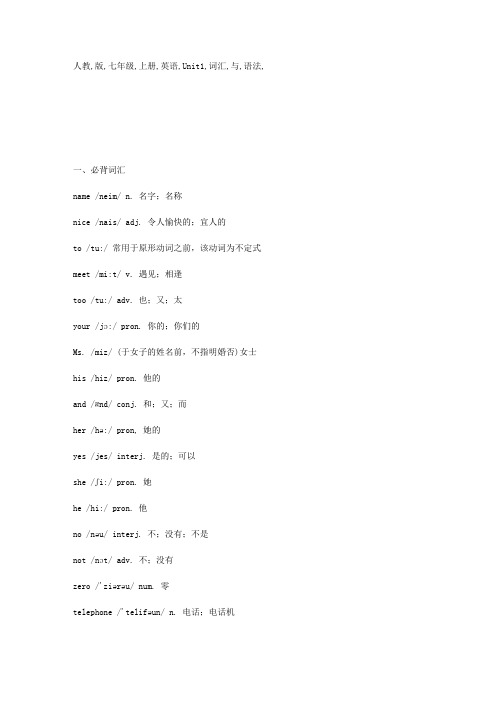
人教,版,七年级,上册,英语,Unit1,词汇,与,语法,一、必背词汇name /neim/ n. 名字;名称nice /nais/ adj. 令人愉快的;宜人的to /tu:/ 常用于原形动词之前,该动词为不定式meet /mi:t/ v. 遇见;相逢too /tu:/ adv. 也;又;太your /jɔ:/ pron. 你的;你们的Ms. /miz/ (于女子的姓名前,不指明婚否)女士his /hiz/ pron. 他的an d /ænd/ conj. 和;又;而her /hə:/ pron, 她的yes /jes/ interj. 是的;可以she /ʃi:/ pron. 她he /hi:/ pron. 他no /nəu/ interj. 不;没有;不是not /nɔt/ adv. 不;没有zero /'ziərəu/ num. 零telephone /'telifəun/ n. 电话;电话机number /'nʌmbə/ n.号码;数字phone /fəun/ n. 电话;电话机telephone/phone number 电话号码first /fə:st/ adj.第一first name 名字last /la:st/ adj. 最后的;末尾的last name 姓friend /frend/ n. 朋友China /'tʃainə/ 中国middle /'midl/ adj. 中间的;中间school /sku:l/ n. 学校middle school 中学;初中二、重点词汇1. nice adjective /naɪs/1). pleasant, enjoyable, or satisfactory 愉快的;美好的;满意的例句:Did you have a nice trip? 你假期过得愉快吗?Have a nice day/time! 祝你度过愉快的一天/过得愉快!2). kind, friendly, or polite 好心的;友善的;有礼貌的例句:I wish you'd be nice to your brother. 我希望你会好好对待你弟弟。
Unit1单词课件人教版七年级上册英语
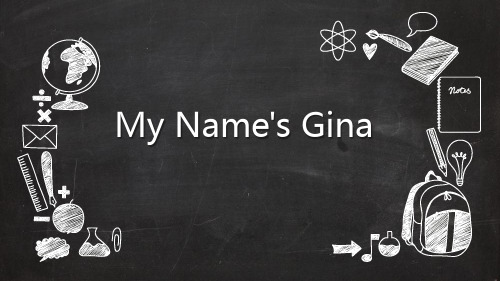
name [neɪm] n.名字 What is your name?
My name is ...
My name is Peppa Pig.
first [fɜ:st] 首要的,第一的 Peppa is my first name.
first name 名
1+1= 2 two 2X4= 8 eight 54÷6=9 nine
Nice to meet you. Nice to meet you, too.
nice [naɪs] adj 好的,愉快的
愉快的一天 a nice day 好天气 nice weather
telephone[ˈtelɪfəʊn]n.电话
电话号码
telephone number Can you tell me your telephone number?
friend [frend] n. 朋友
我有一个好朋友. I have a good friend. 我最好的朋友是... My best friend is ...
China [ˈtʃaɪnə] n. 中国
我有一个好朋友. I have a good friend. 我最好的朋友是... My best friend is from China.
last [lɑ:st] 最后的 Pig is my last name.
last name 姓
Peppa Pig
family name
first name last name 姓
P__e_p__p_a_is her first name andP_i_g___is her last name.
--Is he _____ brother?
人教版七年级上册英语第一单元知识点归纳
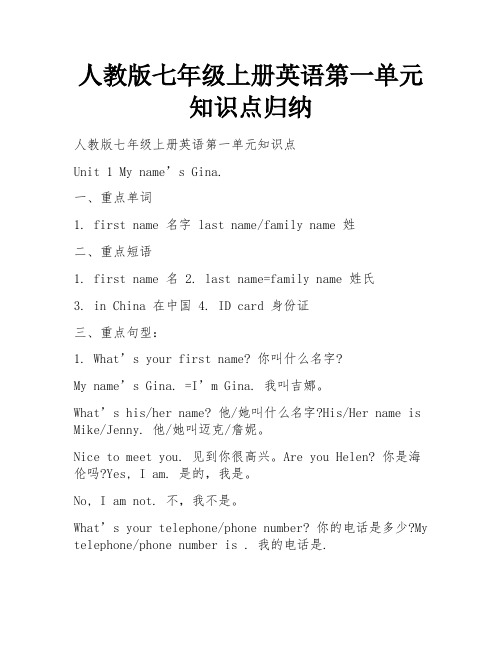
人教版七年级上册英语第一单元知识点归纳人教版七年级上册英语第一单元知识点Unit 1 My name’s Gina.一、重点单词1. first name 名字 last name/family name 姓二、重点短语1. first name 名2. last name=family name 姓氏3. in China 在中国4. ID card 身份证三、重点句型:1. What’s your first name? 你叫什么名字?My name’s Gina. =I’m Gina. 我叫吉娜。
What’s his/her name? 他/她叫什么名字?His/Her name is Mike/Jenny. 他/她叫迈克/詹妮。
Nice to meet you. 见到你很高兴。
Are you Helen? 你是海伦吗?Yes, I am. 是的,我是。
No, I am not. 不,我不是。
What’s your telephone/phone number? 你的电话是多少?My telephone/phone number is . 我的电话是.What’s your last/family name? 你姓什么?My last/family name’s Smith. 我姓史密斯。
Two and three is five. 二加三等于五。
语法讲解代词(人称代词和物主代词)① 形容词性物主代词在句中修饰名词,其后必须加名词,否则为不正确的。
例:Myisyellow.(错误)---->Myjacketisyellow.(正确)② 人称代词及相对应的形容词性物主代词和be动词③ 主语和宾语的定义。
(1)主语表示句子主要说明的人或事,一般由名词、代词、数词、不定式充当。
例:HelikeswatchingTV.他喜欢看电视。
MaryisanEnglishgirl.玛丽是一个英国女孩。
新人教版七年级英语上册第一单元
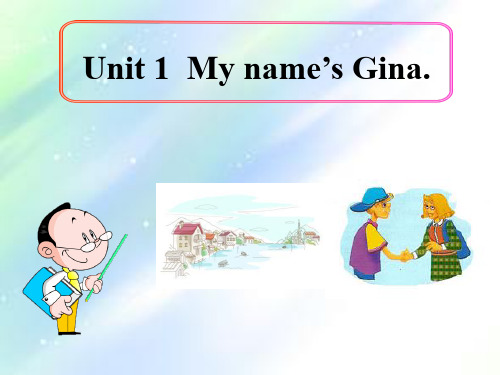
correct answers on the right.
Hello!/Hi !
Good morning.
Good morning.
Hello!/Hi !
Good afternoon.
How do you do?
Good evening.
Good afternoon.
Nice to meet you.
C
A.Hello B.Hi C.Nice to meet youD.Good.
3.I ___Sally. What ___ your name?
A
A.am is B.is am C.is is D.am am
4.___name is Li Lei.
C
A.I B. I am C.My D.You
5.--___,what’s your name?—John Green. A
• 能听懂对话,根据对话进行自由交际: 1.听录音,给对话编号 2.根据对话进行交际, 3.展示对话
1b Listen and number the conversations[1-3]. 听录音,为对话编号。
2
A: What’s your name?
B: Alan.
A:Hello, Alan. I’m Ms. Brown
Unit 1 My name’s Gina.
学习目标
• 掌握词汇:name clock my your meet • 学会介绍并询问他人姓名,能够利用所学
知识进行打招呼。 • 能够听懂对话并根据对话进行自由交际。 • 懂得礼貌待人,学习跟人合作。
学习重点
• 学会打招呼并介绍自己,询问他人姓名的 句型; Nice to meet you. What’s your name? My name is …/I’m …
- 1、下载文档前请自行甄别文档内容的完整性,平台不提供额外的编辑、内容补充、找答案等附加服务。
- 2、"仅部分预览"的文档,不可在线预览部分如存在完整性等问题,可反馈申请退款(可完整预览的文档不适用该条件!)。
- 3、如文档侵犯您的权益,请联系客服反馈,我们会尽快为您处理(人工客服工作时间:9:00-18:30)。
∙•人教版初一上册英语1——12单元知识点归纳1回答2010-02-25∙•初二英语上册第一单元知识点1回答2011-07-05∙•跪求8年级英语上册第二单元测验的知识点。
要会什么!!!!1回答2011-10-07 ∙•谁有北师大版初一上册数学的知识点(只要1,2单元的!!)急!!1回答2008-09-29 ∙•初一历史上册知识点1回答2011-10-02更多初一英语上册知识点相关知识>>∙初一数学上册知识点∙初一地理上册知识点∙初一生物上册知识点∙初一语文上册知识点∙初一政治上册知识点∙初一历史上册知识点∙初二英语上册知识点∙人教版初一英语上册答案哪种版本的,人教吗豌豌豌豌豆、2011-02-16 18:35好:0不好:0一. 词汇⑪ 单词1. 介词:in, on, under, behind, near, at, of1). in表示"在……中", "在……内"。
例如:in our class 在我们班上in my bag 在我的书包里in the desk 在桌子里in the classroom 在教室里2). on 表示"在……上"。
例如:on the wall 在墙上on the desk 在桌子上on the blackboard 在黑板上3). under表示"在……下"。
例如:under the tree 在树下under the chair 在椅子下under the bed 在床下4). behind表示"在……后面"。
例如:behind the door 在门后5). near表示"在……附近"。
例如:near the teacher's desk 在讲桌附近near the bed 在床附近6). at表示"在……处"。
例如:at school 在学校at home 在家at the door 在门口7). of 表示"……的"。
例如:a picture of our classroom 我们教室的一幅画a map of China 一张中国地图2. 冠词 a / an / the:冠词一般位于所限定的名词前,用来署名名词所指的人或事物。
冠词有不定冠词和定冠词两种。
不定冠词有两个形式,即a和an。
a用在以辅音音素开头的词前,如a book; an用在以元音音素开头的字母前,如an apple.a或an与可数名词单数连用,泛指某类人或某物中的一个。
This is a cat.这是一只猫。
It's an English book.这是一本英语书。
His father is a worker.他的爸爸是个工人。
the既可以用在可数名词前,也可以用在不可数名词前,表示某个或某些特定的人或事物,也可以指上文提到过的人或事物。
Who's the boy in the hat?戴帽子的男孩是谁呀?------ What can you see in the classroom?------ I can see a bag.------ Where's the bag?------ It's on the desk.------- 你能在教室里看到什么呀?------ 我能看见一个书包。
------ 书包在哪呀?------ 在桌子上。
3.some和any①在肯定句中用some.例如:There are some books on the desk.桌子上有一些书。
Lucy has some good books露西有一些好书。
②在疑问句和否定句中用any。
例如:Is there any ink in your pen?你的钢笔里有墨水吗?Do you have any brothers and sisters?你有兄弟姐妹吗?⑫记住它们的特殊用法。
①some亦可用于表示盼望得到对方肯定的答复或表示建议、委婉请求的疑问句中,这一点我们不久就会学到。
例如:Would you like to have some apples?你想吃苹果吗?②any也可用于肯定句中,表示"任何的"。
例如:Any one of us can do this.我们当中任何一个都能做这个。
some 和any的用法是经常出现的考点,希望大家能准确地掌握它们的用法。
4.familyfamily看作为一个整体时,意思是"家庭",后面的谓语动词be用单数形式 is ;如把family 看作为家庭成员时,应理解为复数,后面的谓语动词be应用are。
My family is a big family. 我的家庭是个大家庭。
My family are all at home now. 我的家人现在都在家。
Family强调由家人组成的一个集体或强调这个集体中的成员。
home指个人出生、被抚养长大的环境和居住地点。
house指"家"、"房屋",侧重居住的建筑本身。
His family are all workers. 他的家人都是工人。
My home is in Beijing. 我的家在北京。
He isn't at home now. 他现在不在家。
It's a picture of my family. 这是一张我全家的照片。
5. little的用法a little dog 一只小狗,a little boy 一个小男孩。
little常用来修饰有生命的名词。
*但little还可表示否定意义,意为"少的",加不可数名词。
There is little time. 几乎没时间了。
There is little water in the cup. 杯中水很少。
⑫ 词组on the desk 在桌子上behind the chair 在椅子后under the chair 在椅子下面in her pencil-box 在她的铅笔盒中near the door 在门附近a picture of a classroom 一个教室的图片look at the picture 看这张图片the teacher's desk 讲桌a map of China 一张中国地图family tree 家谱have a seat 坐下,就坐this way 这边走二. 日常用语1. Come and meet my family.2. Go and see. I think it's Li Lei.4. What can you see in the picture?I can see a clock / some books.5. Can you see an orange?Yes, I can. / No, I can't.6. Where's Shenzhen?It's near Hong Kong.7. Let me see.(口语)让我想想看。
see 在这是"明白、懂了",不可译作"看见"。
例如:8. Please have a seat.seat表示"座位",是个名词。
have a seat表示"就坐",也可以说take a seat, 和sit down 的意思相同。
三. 语法1. 名词所有格名词如要表示与后面名词的所有关系,通常用名词所有格的形式,意为"……的"。
一般有以下几种形式:(1). 一般情况下在词尾加"'s"。
例如:Kate's father Kate的爸爸my mother's friend 我妈妈的朋友(2). 如果复数名词以s结尾,只加"'"。
例如:Teachers' Day 教师节The boys' game 男孩们的游戏(3). 如果复数名词不以s结尾,仍加"'s"。
例如:Children's Day 儿童节Women's Day 妇女节(4). 表示两个或几个共有时,所有格应加在后一个名词上。
例如:Lucy and Lily's room Lucy 和Lily的房间Kate and Jim's father Kate 和Jim的爸爸动物和无生命事物的名词的所有格一般不在词尾加"'s",而常常用介词of的短语来表示。
a map of China 一幅中国地图the name of her cat 她的猫的名字a picture of my family 我的家庭的一张照片the door of the bedroom 卧室的门2. 祈使句祈使句主要用来表示说话人的请求、命令、建议、叮嘱等意图。
祈使句一般不用主语,读时用降调。
为使语气委婉、礼貌,常在句首或句尾加please 。
在句尾时,please前多用逗号。
Come in, please. 请进。
(2). 祈使句的否定形式常用don't于句首。
Don't look at your books. 不要看书。
Don't play on the road. 不要在马路上玩。
3. There be 的句子结构There be是一个"存在"句型,表示"有"的意思,肯定句的形式为:There be + 名词(单数或复数)+地点状语或时间状语。
be动词单复数的确定,看be后边第一个名词,当所接主语为单数或不可数名词时,be动词形式为is;当所接主语为复数名词时,be动词为are;当be动词后接两个以上主语时,be动词与最临近主语保持数上的一致。
意思为"某地有某人或某物"。
如:There is an eraser and two pens on the desk. 桌子上有一块橡皮和两支钢笔。
There are two pens and an eraser on the desk. 桌上有两支钢笔和一块橡皮。
(1)there be的否定句,即在be的后面加上not。
否定形式为:There be + not + (any) + 名词+地点状语。
There is not any cat in the room. 房间里没猫。
